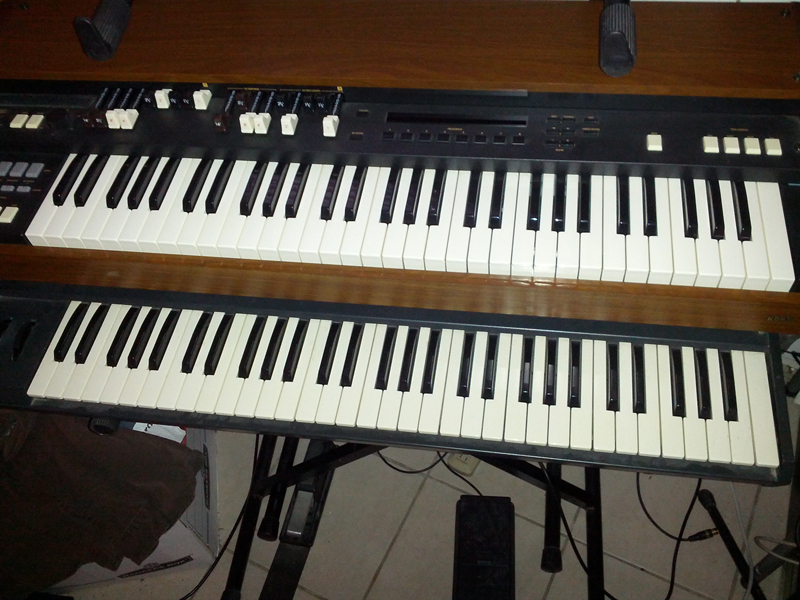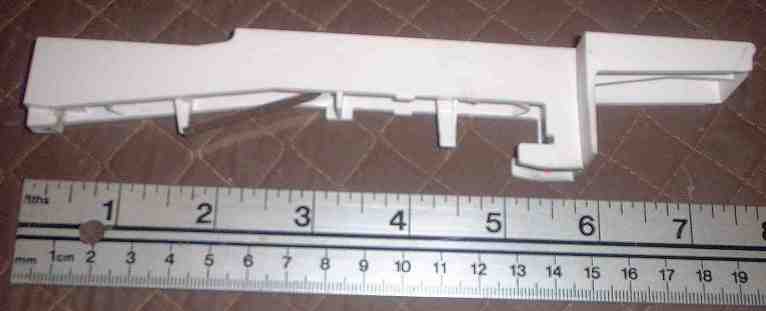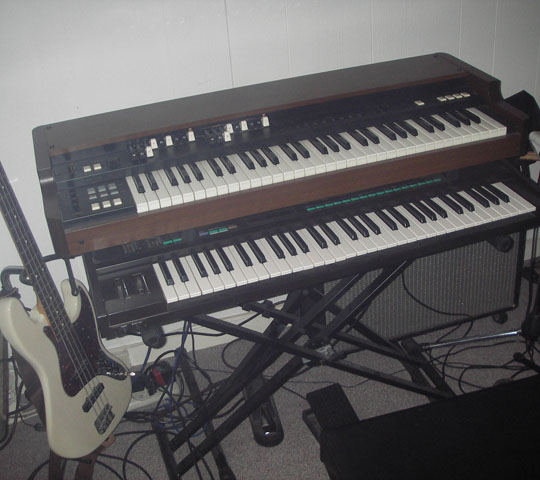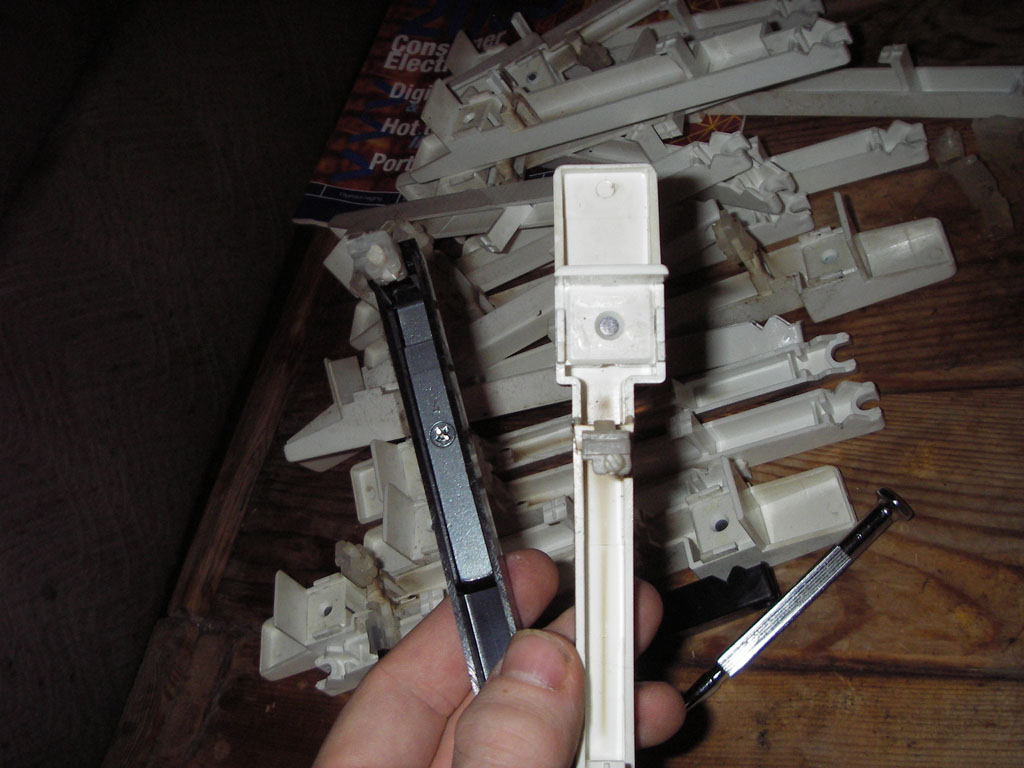Hammond organ keybed "FEEL"
-
- KVRer
- Topic Starter
- 24 posts since 5 Jan, 2011 from USA
The "butter" - that feel of a real B-3. Nothing else even approaches the same galaxy. Cannot begin to count the keyboards I've gone through searching for that ultimate feel and response. The Korg CX3 had the right idea, sort of, with the notion that sound should begin to occur with even the slightest depression, but still paled in comparison. So why can't manufacturers replicate a keybed that was built 78 years ago? Accomplish that and, one would think, millions of frustrated keyboardists would beat a path to your door. Any thoughts?
-
- D.H. MOD
- 16419 posts since 21 Jun, 2008
Probably just misposted in all the excitement. Moved to Hardware.
No longer a moderator.
-
- KVRist
- 433 posts since 29 Jun, 2008 from Mid Wales, UK.
You might well expect this to exist, but it seems that if Fatar don't make it, you can't have it.
Some Fatar keybeds do support a high trigger, but not it seems also with a light action. AFAIK, their waterfall keybed is only available semi-weighted.
If they did make a keyboard especially for electric organ - it would be very expensive, as their digital classical organ keybeds are. Anything made especially for organists are always expensive!
I have a Nord E4 with the semi-weighted waterfall. It's a fair compromise I suppose on an instrument that's also Piano and EP etc, but I would be happy with a light synth action for everything. Piano players on the other hand would hate that so they try to please every one with something in between.
Some Fatar keybeds do support a high trigger, but not it seems also with a light action. AFAIK, their waterfall keybed is only available semi-weighted.
If they did make a keyboard especially for electric organ - it would be very expensive, as their digital classical organ keybeds are. Anything made especially for organists are always expensive!
I have a Nord E4 with the semi-weighted waterfall. It's a fair compromise I suppose on an instrument that's also Piano and EP etc, but I would be happy with a light synth action for everything. Piano players on the other hand would hate that so they try to please every one with something in between.
-
- KVRAF
- 6804 posts since 20 Jan, 2008
There is a "New mini B3" from Hammond which attempts to do just that. It has ten contacts per key. And 96 processors Just priced like a Hammond.
-
AdmiralQuality AdmiralQuality https://www.kvraudio.com/forum/memberlist.php?mode=viewprofile&u=83902
- Banned
- 6657 posts since 10 Oct, 2005 from Toronto, Canada
I too am always looking for a keyboard with waterfall keys.
The Korg CX-3 (the digital kind from 2001, not the early '80s analog one) is pretty decent. It had two kinds of keyboards though. The early ones (on the first 3000 units if I remember correctly) have a narrow "lip" on the key front (so they don't look exactly right) however they have a nice light action. I have one. They changed it because some were complaining about retriggering when a key is suddenly released (they tend to bounce a bit when they spring back to the up position -- which frankly I consider to be a musically playable FEATURE! ). The later keyboard doesn't feel as nice to me, but doesn't have this bouncing/retriggering "problem". You can tell the difference as it doesn't have the little "lip" on the front, it looks like the classic waterfall keys. Which does yours have?
). The later keyboard doesn't feel as nice to me, but doesn't have this bouncing/retriggering "problem". You can tell the difference as it doesn't have the little "lip" on the front, it looks like the classic waterfall keys. Which does yours have?
There are a few other issues at play here. One is velocity sensitivity. The way modern keyboards detect key velocity is by measuring the time it takes for the key to go from opening a contact at the top of the travel to closing another contact at the bottom of its travel. The Korg CX-3 lets you trigger the organ from only the top key contact, if you wish (as velocity information isn't needed). This goes a long way to giving it that shallow trigger depth that you get on a real Hammond.
The other issue is the key length.
Here's what a typical electronic keyboard key looks like:

As you can see, the fulcrum point is just behind the top of the key. Due to the mechanical disadvantage this requires dramatically more force to depress when you press near the inner part of the key vs. the outer portion.
And here's what the keys of a REAL Hammond look like:

As you can see the fulcrum point is almost an entire key length back, greatly evening the feel across the key. The obvious reason why modern keyboard manufacturers don't do this is mostly size and to some degree, weight. But if someone DID do this, I'd run out and buy their product immediately.
I'm looking for a good Hammond-like keyboard to put under my CX-3 to use as a lower manual. Preferably something I can modify and build a new cabinet for to match the CX-3. (That's how I found this thead, actually.) I picked up a used M-Audio Keystation 61 ES a few months ago as it seems to be a good project board for modifications, but I hate the feel of its action so I'm not sure I'm going to bother. (I'm using an old 1986 Ensoniq ESQ-1 instead, which due to its flat top fits nicely under the CX-3, but it's still no near as close together as real Hammond manuals. It's got a very organ-like action, much nicer than many modern synth 'boards. But I'd also rather not carry it go gigs as it's old and has a lot of sentimental value.

)
One option I'd happily consider is finding a busted old A/B/C 1/2/3 and cannibalizing the keyboard.
As for the 9 contacts thing, there's not much we can do about that (short of that modern Hammond model mentioned above that puts digital "drawbars" on analog busbars just like the original -- but you can forget MIDI and the ability to use that with any other instrument). On a real Hammond, if you pull out all the stops and VERY slowly lower a key, you will hear each of the 9 switches come on individually. This actually gave Hammonds a kind of reverse velocity sensitivity, as the 9 key clicks have more time between them when played slow than when played fast.
Let us know if you find any good substitutes.
The Korg CX-3 (the digital kind from 2001, not the early '80s analog one) is pretty decent. It had two kinds of keyboards though. The early ones (on the first 3000 units if I remember correctly) have a narrow "lip" on the key front (so they don't look exactly right) however they have a nice light action. I have one. They changed it because some were complaining about retriggering when a key is suddenly released (they tend to bounce a bit when they spring back to the up position -- which frankly I consider to be a musically playable FEATURE!
There are a few other issues at play here. One is velocity sensitivity. The way modern keyboards detect key velocity is by measuring the time it takes for the key to go from opening a contact at the top of the travel to closing another contact at the bottom of its travel. The Korg CX-3 lets you trigger the organ from only the top key contact, if you wish (as velocity information isn't needed). This goes a long way to giving it that shallow trigger depth that you get on a real Hammond.
The other issue is the key length.
Here's what a typical electronic keyboard key looks like:

As you can see, the fulcrum point is just behind the top of the key. Due to the mechanical disadvantage this requires dramatically more force to depress when you press near the inner part of the key vs. the outer portion.
And here's what the keys of a REAL Hammond look like:

As you can see the fulcrum point is almost an entire key length back, greatly evening the feel across the key. The obvious reason why modern keyboard manufacturers don't do this is mostly size and to some degree, weight. But if someone DID do this, I'd run out and buy their product immediately.
I'm looking for a good Hammond-like keyboard to put under my CX-3 to use as a lower manual. Preferably something I can modify and build a new cabinet for to match the CX-3. (That's how I found this thead, actually.) I picked up a used M-Audio Keystation 61 ES a few months ago as it seems to be a good project board for modifications, but I hate the feel of its action so I'm not sure I'm going to bother. (I'm using an old 1986 Ensoniq ESQ-1 instead, which due to its flat top fits nicely under the CX-3, but it's still no near as close together as real Hammond manuals. It's got a very organ-like action, much nicer than many modern synth 'boards. But I'd also rather not carry it go gigs as it's old and has a lot of sentimental value.

)
One option I'd happily consider is finding a busted old A/B/C 1/2/3 and cannibalizing the keyboard.
As for the 9 contacts thing, there's not much we can do about that (short of that modern Hammond model mentioned above that puts digital "drawbars" on analog busbars just like the original -- but you can forget MIDI and the ability to use that with any other instrument). On a real Hammond, if you pull out all the stops and VERY slowly lower a key, you will hear each of the 9 switches come on individually. This actually gave Hammonds a kind of reverse velocity sensitivity, as the 9 key clicks have more time between them when played slow than when played fast.
Let us know if you find any good substitutes.
-
AdmiralQuality AdmiralQuality https://www.kvraudio.com/forum/memberlist.php?mode=viewprofile&u=83902
- Banned
- 6657 posts since 10 Oct, 2005 from Toronto, Canada
Interesting...
http://jimsmileymusic.blogspot.ca/2010/ ... or-ni.html
I think that's what I must get! They look like waterfall keys, and the fulcrum, while not far back enough, is at least farther back than most electronic keybeds. (I'm pretty sure they made the keyboard in my ESQ-1 too.)
http://jimsmileymusic.blogspot.ca/2010/ ... or-ni.html
http://www.fatar.com/pages/TP_8O.htmIt's probably a hell of a lot easier to simply purchase the Fatar TP/80 keybed from Doepfer or Analogue Haven
I think that's what I must get! They look like waterfall keys, and the fulcrum, while not far back enough, is at least farther back than most electronic keybeds. (I'm pretty sure they made the keyboard in my ESQ-1 too.)
-
- KVRist
- 145 posts since 3 Feb, 2011
Interesting. Key length and fulcrum point appears to be a big part of what most keyboardists regard was good. The Yamaha FS synth action keys (DX7 / Triton / Wavestation / 01/W) are much longer than the typical keyboard keys (not as long as the B3, obviously) and are regarded by many as some of the best synth keys ever made.

-
AdmiralQuality AdmiralQuality https://www.kvraudio.com/forum/memberlist.php?mode=viewprofile&u=83902
- Banned
- 6657 posts since 10 Oct, 2005 from Toronto, Canada
Yep. I used to use a DX-7 as my lower manual before my music partner gave me our old ESQ-1. And for the exact same reasons. It was flat on top so I could get it in close, and had a very nice "organy" feel as well. And while unweighted, both keyboards are very responsive to force. Normally it's hard to control key velocity against only a spring which has a constant force, vs. moving a significant amount of mass where you have a greater force the faster you try to accelerate it. But for certain unweighted keyboards like this, they manage to get it right. (And while we don't need velocity sensitivity on our organ keyboards, it's nice to have in case we're controlling anything else with them.)

EDIT: Actually, I seem to recall some little lead or steel masses in either the ESQ-1 or DX-7 keyboards. But I can't recall which offhand. So I guess one or both of them are "semi-weighted".

EDIT: Actually, I seem to recall some little lead or steel masses in either the ESQ-1 or DX-7 keyboards. But I can't recall which offhand. So I guess one or both of them are "semi-weighted".
Last edited by AdmiralQuality on Sat Nov 16, 2013 4:38 pm, edited 1 time in total.
-
AdmiralQuality AdmiralQuality https://www.kvraudio.com/forum/memberlist.php?mode=viewprofile&u=83902
- Banned
- 6657 posts since 10 Oct, 2005 from Toronto, Canada
Just dug up the photos of my ESQ-1 restoration and that's where I'm remembering the steel weights from. Long one in the black keys, and I think a shorter one is hidden in the plastic at the tip of the white keys. You can see the metal through the little round hole.

Can't seem to find any pics from my DX-7 restoration. Maybe I didn't take any.

Can't seem to find any pics from my DX-7 restoration. Maybe I didn't take any.
-
- KVRist
- 433 posts since 29 Jun, 2008 from Mid Wales, UK.
The Fatar TP80 waterfall keybed though is semi-weighted - a heavier feel than a synth action "diving board" keybed (Hammond Spinet models like the L100 has diving board keys ). The Fatar Waterfall is the one in the Nords (which also have "high trigger") and most likely the later Korg CX3 too. (Studiologic made a control keyboard with the Fatar TP80).
I have heard of people changing the springs in the TP80 for a lighter action.
I have heard of people changing the springs in the TP80 for a lighter action.
-
AdmiralQuality AdmiralQuality https://www.kvraudio.com/forum/memberlist.php?mode=viewprofile&u=83902
- Banned
- 6657 posts since 10 Oct, 2005 from Toronto, Canada
"Diving-board" and "waterfall" only describe the shape of the keys. You can potentially have weighted, unweighted or semi-weighted for any of them. And for piano performances, nothing less than a hammer action will do! (I can't stand Yamaha digital pianos for this reason. They have no hammer feel!)Jim Y wrote:The Fatar TP80 waterfall keybed though is semi-weighted - a heavier feel than a synth action "diving board" keybed (Hammond Spinet models like the L100 has diving board keys ). The Fatar Waterfall is the one in the Nords (which also have "high trigger") and most likely the later Korg CX3 too. (Studiologic made a control keyboard with the Fatar TP80).
I have heard of people changing the springs in the TP80 for a lighter action.
The high-trigger thing isn't a feature of the keyboard. It's done in firmware.
I sometimes wonder if I could buy a replacement keyboard for my CX-3 and turn it into a BX-3. There's an empty spot on the motherboard where the ribbon to the BX-3 (the 2 manual version of the CX-3) keyboard would go.
The Hammond M-3 is a spinet with waterfall keys, by the way. But yes, the L and other M models used yucky diving-board keys.
It's for all these reasons that I have so little interest in "do everything" keyboard workstations. I can't play piano without a piano action, can't play organ without an organ action, don't want to play synth without Moog style pitch and mod wheels, etc.
-
- KVRist
- 433 posts since 29 Jun, 2008 from Mid Wales, UK.
I know that Fatar don't do business with individuals, but as you probably know, Doepfer sell the keybeds (and I think it includes the contact loom - probably flexi pcb thing). If Korg did use a Fatar keybed, then there is a chance the loom matches 1to1 with the BX second keyboard connector?
Doepfer do their own scanner module to generate MIDI from a Fatar keybed, but I don't know if it has the high trigger option.
Doepfer do their own scanner module to generate MIDI from a Fatar keybed, but I don't know if it has the high trigger option.
-
AdmiralQuality AdmiralQuality https://www.kvraudio.com/forum/memberlist.php?mode=viewprofile&u=83902
- Banned
- 6657 posts since 10 Oct, 2005 from Toronto, Canada
Well, I was thinking of ordering the part from Korg. But not sure it's actually possible to patch into the CX-3. It's clearly the same motherboard as the BX-3, but I think it KNOWS it's a CX-3 and wouldn't accept the BX-3 firmware. (Though maybe adding the keyboard clues it in? Who knows!) There's a few other differences between the CX-3 and BX-3 aside from the lower manual (pitch and mod wheels are what comes to mind, but there might be a couple of other things I'm not thinking of).Jim Y wrote:I know that Fatar don't do business with individuals, but as you probably know, Doepfer sell the keybeds (and I think it includes the contact loom - probably flexi pcb thing). If Korg did use a Fatar keybed, then there is a chance the loom matches 1to1 with the BX second keyboard connector?
Doepfer do their own scanner module to generate MIDI from a Fatar keybed, but I don't know if it has the high trigger option.
Probably wouldn't work. And impossible to find out without spending money and getting destructive on my nice, mint CX-3.
Anyone in Toronto area want to trade a BX-3 for a CX-3 + $???
And yes, getting one already MIDI rigged from Doepfer would be the safest way to go. Though then you lose the "high trigger" option.
-
- KVRAF
- 6426 posts since 22 Jan, 2005 from Sweden
At last - a clonewheel thread again.AdmiralQuality wrote: And yes, getting one already MIDI rigged from Doepfer would be the safest way to go. Though then you lose the "high trigger" option.
Did anyone try the options that just about all midi keyboards/synths have had(in my posession) - the option of fixed velocity?
One could suspect that fixed velocity is for organ use - and they simulate shallow by using first trigger. They really don't need second level.
This option is mostly among the velocity curves settings.
Never tried it though.
I mean, even CX-3 v2 has option to set a midi send and receive channel with velocity - beside the shallow trigger channels. So it's done with an ordinary keybed it seems - and firmware use the first trigger level for shallow with a fixed velocity.
So you have a versatile keybed in CX-3 for synth and piano use as well, kind of.
But talking to keyboard vendors might make firmware patches that allow shallow triggering - if not already. But might not be in demand, I don't know.




